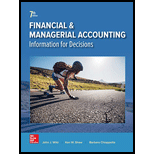
Concept explainers
Current Assets:
Current assets are short term assets which are likely to be turn into cash within a year. For example, cash, accounts receivable, inventories and many more.
Long-term Investments:
Any investment that company makes with a view of keeping it for more than one year is called long-term investments.
Plant Assets:
Any assets whose useful life is more than one year and which is use to facilitate the production process is called plant assets.
Intangible Assets:
Intangible assets are those assets which do not have a physical nature but yet has value for the company. For example: Patent and
Current Liabilities:
Any liability which needs to be paid within one year is called current liability.
Long-term Liabilities:
Any liability which is not due to be paid within one year is called long- term liability.
Equity:
It is shareholder’s fund. It is that part of the company's liabilities that are used to finance the operations of the business. They are the owner of the business.
To identify: To indicate correct letter against each balance sheet item.
Want to see the full answer?
Check out a sample textbook solution
Chapter 3 Solutions
Financial and Managerial Accounting

 AccountingAccountingISBN:9781337272094Author:WARREN, Carl S., Reeve, James M., Duchac, Jonathan E.Publisher:Cengage Learning,
AccountingAccountingISBN:9781337272094Author:WARREN, Carl S., Reeve, James M., Duchac, Jonathan E.Publisher:Cengage Learning, Accounting Information SystemsAccountingISBN:9781337619202Author:Hall, James A.Publisher:Cengage Learning,
Accounting Information SystemsAccountingISBN:9781337619202Author:Hall, James A.Publisher:Cengage Learning, Horngren's Cost Accounting: A Managerial Emphasis...AccountingISBN:9780134475585Author:Srikant M. Datar, Madhav V. RajanPublisher:PEARSON
Horngren's Cost Accounting: A Managerial Emphasis...AccountingISBN:9780134475585Author:Srikant M. Datar, Madhav V. RajanPublisher:PEARSON Intermediate AccountingAccountingISBN:9781259722660Author:J. David Spiceland, Mark W. Nelson, Wayne M ThomasPublisher:McGraw-Hill Education
Intermediate AccountingAccountingISBN:9781259722660Author:J. David Spiceland, Mark W. Nelson, Wayne M ThomasPublisher:McGraw-Hill Education Financial and Managerial AccountingAccountingISBN:9781259726705Author:John J Wild, Ken W. Shaw, Barbara Chiappetta Fundamental Accounting PrinciplesPublisher:McGraw-Hill Education
Financial and Managerial AccountingAccountingISBN:9781259726705Author:John J Wild, Ken W. Shaw, Barbara Chiappetta Fundamental Accounting PrinciplesPublisher:McGraw-Hill Education





